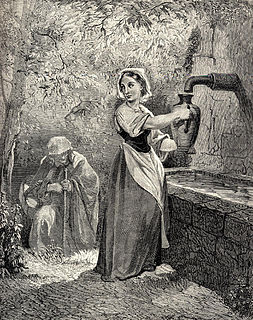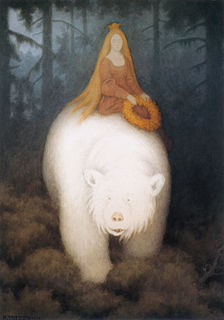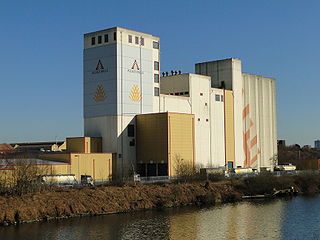Related Research Articles

Millstones or mill stones are stones used in gristmills, for grinding wheat or other grains. They are sometimes referred to as grindstones or grinding stones.

"The Reeve's Tale" is the third story told in Geoffrey Chaucer's The Canterbury Tales. The reeve, named Oswald in the text, is the manager of a large estate who reaped incredible profits for his master and himself. He is described in the Tales as skinny and bad-tempered and old; his hair is closely cropped reflecting his social status as a serf. His sword is rusty while he rides a fine gray horse called Scot. The Reeve is a skilled carpenter, a profession mocked in the previous "Miller's Tale". Oswald responds with a tale that mocks the Miller's profession.
Grist is grain that has been separated from its chaff in preparation for grinding. It can also mean grain that has been ground at a gristmill. Its etymology derives from the verb grind.

Diamonds and Toads or Toads and Diamonds is a French fairy tale by Charles Perrault, and titled by him "Les Fées" or "The Fairies". Andrew Lang included it in The Blue Fairy Book. It was illustrated by Laura Valentine in Aunt Louisa's nursery favourite.
The Three Heads in the Well is a fairy tale collected by Joseph Jacobs in English Fairy Tales.

Vasilisa the Beautiful or Vasilisa the Fair is a Russian fairy tale collected by Alexander Afanasyev in Narodnye russkie skazki.

"Katie Woodencloak" or "Kari Woodengown" is a Norwegian fairy tale collected by Peter Christen Asbjørnsen and Jørgen Moe in Norske Folkeeventyr. Andrew Lang included it in The Red Fairy Book.
Snow-White-Fire-Red (Bianca-comu-nivi-russa-comu-focu) is a Sicilian fairy tale collected by Giuseppe Pitre and translated by Thomas Frederick Crane in Italian Popular Tales.

Father Frost is a Russian fairy tale collected by Alexander Afanasyev in Narodnye russkie skazki (1855-63). Andrew Lang included it, as "The Story of King Frost", in The Yellow Fairy Book (1894).
The Two Caskets is a Scandinavian fairy tale included by Benjamin Thorpe in his Yule-Tide Stories: A Collection of Scandinavian and North German Popular Tales and Traditions. Andrew Lang included it in The Orange Fairy Book.

"Donkey Cabbages" is a German fairy tale collected by the Brothers Grimm, tale number 122. A man shoots birds in a forest and gains magical objects. By also ingesting the heart of one of the bird he shot, he acquires an inexhaustible source of wealth. Later on, his magical abilities and items are stolen by a trio of witches, but regains thanks to a magical herb that causes a transformation into donkeys.
The Grateful Prince is an Estonian fairy tale.
Molly Whuppie is an English fairy tale set in Scotland and collected by Joseph Jacobs in English Fairy Tales. A Highland version, Maol a Chliobain, was collected by John Francis Campbell in Popular Tales of the West Highlands. Jacobs noted the relationship between the two tales, and an Irish variant, "Smallhead," and concluded that the tale was Celtic in origin.
The Little Good Mouse is a French literary fairy tale written by Madame d'Aulnoy. Andrew Lang included it in The Red Fairy Book.
Finette Cendron is a French literary fairy tale written by Madame d'Aulnoy.
The Old Witch is an English fairy tale collected by Joseph Jacobs in his 1894 book, More English Fairy Tales. It is also included within A Book of Witches by Ruth Manning-Sanders and A Book of British Fairy Tales by Alan Garner.

White-Bear-King-Valemon is a Norwegian fairy tale. The tale was published as No. 90 in Asbjørnsen and Moe's Norske Folke-Eventyr. Ny Samling (1871). George Webbe Dasent translated it for his Tales from the Fjeld.
Beauty and Pock Face is a Chinese fairy tale collected by Wolfram Eberhard in Chinese Fairy Tales and Folk Tales.
"Mossycoat" is a fairy tale collected by Katherine M. Briggs and Ruth I. Tongue in Folktales of England. It appears in A Book of British Fairy Tales by Alan Garner. The story known by folklorists was told was Taimi Boswell, a Romani, at Oswaldtwistle, Lancashire, January 9, 1915.

A gristmill grinds cereal grain into flour and middlings. The term can refer to either the grinding mechanism or the building that holds it. Grist is grain that has been separated from its chaff in preparation for grinding.
References
- 1 2 Soula Mitakidou and Anthony L. Manna, with Melpomeni Kanatsouli, Folktales from Greece: A Treasury of Delights, p 61 ISBN 1-56308-908-4